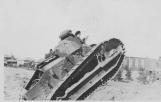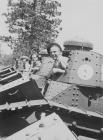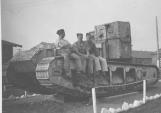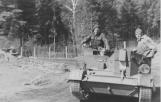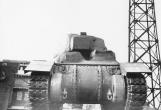16
No sooner had the Regiment begun to feel comfortable in the role with the motorcycles than orders were received in February 1941 that the unit was again to be converted, this time into a tank regiment. The new name was to be the 9th Canadian Armoured Regiment (BCD) with its strength increased to 583 all ranks. It was under this designation that the unit fought as armour throughout the balance of the war, as part of the 5th Canadian Armoured Division (5thCAD) or the "Mighty Maroon Machine" as it came to be known, owing to the colour of the divisional badge.In May 1941 the motorcycles were turned in and the Dragoons boarded train for Camp Borden in southern Ontario. There they received their first armour training at the Canadian Armoured Fighting Vehicles Training Centre established by Major Frank F. Worthington in 1939. He is considered the founder of the Canadian Armoured Corps.
When the active unit changed to tanks, the militia unit was renamed the 9th (Reserve) Armoured Regiment (BCD), with an authorized establishment of 32 officers and 548 other ranks. During the war and average of 250-350 men actually served at any one time, with approximately 200 going to the annual summer camps. Those in the reserve unit were primarily men whose jobs at home were deemed essential to the war effort, and those who did not satisfy the age or fitness requirements of active service. Squadrons remained in Vernon, Kelowna and Penticton. They served as a reminder to the local population of the unit overseas, and as a link to the active force men. In this they were supported by the BCD Women's Auxiliary. Formed in 1940 while the active force unit was training with motorcycles on Vancouver Island, it was primarily an organization of the families of the men in the Regiment. Throughout the war and especially after the unit went overseas, the Auxiliary performed admirably in raising morale by regularly sending cigarettes, Reader's Digest magazines, hand-knitted socks and scarves, and Christmas packages, as well as money for parties and 'smokers.' Most of the funds supporting these activities were raised at dances, through the sale of raffle tickets, on
'tag days' and by donations.
For the active force unit at Camp Borden, the main problem during the summer of 1941 was again the lack of equipment. The only tanks available were American made WW I French designed antiques, which continually broke down. This was not surprising as, at the outbreak of war, Canada had but 14 tanks in the entire country, and with no facilities to manufacture them. Much training, therefore, took place on the "RYPA" or Roll, Yaw, Pitch, Alternate Apparatus, which simulated the operation of a tank turret and gun. Interspersed with the practical training was course work in the construction and maintenance of tanks. Nearly half the personnel would need to be tradesmen, skilled in keeping the tanks in the fighting echelon in proper working order. Some of the familiarization and training was done at the actual manufacturing plants in the US and Canada.
17
'A' Squadron, 9th Canadian Armoured Regiment (BCD) Reserve in Vernon.May, 1942
Vernon, BC, Canada
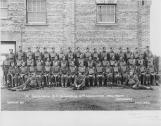
23
Some of the Okanagan boys enjoy the sunshine of Camp Borden during the summer training in 1941.1941
Camp Borden, Ontario, Canada

24
After six months in Camp Borden the Regiment sailed overseas, arriving in Liverpool, England in November 1941. For the next two years the Regiment was to remain in England, training primarily on the plains in the southern part of the country. Continuous blackouts and the removal of road signs made it difficult for find one's way around at night. While on leave the troops were required to carry their helmets, gas masks and weapons everywhere, in case the German actually invaded the British Isles. Gasoline and food were strictly rationed. Mail delivery was free, but censored.Without tanks during its first months in Britain, training for the Regiment consisted of route marches, rifle range and grenade throwing practise, map reading and the like. As at Camp Borden, a number of men were assigned to schools elsewhere for courses in subjects like gunnery, wireless communications, and driving and maintenance. As the winter of 1941-1942 wore on, morale declined. In fact, there was talk that the Regiment might be broken up for reinforcements for other units. On one wished this: so a short time and much hard work later, when King George VI and Queen Elizabeth inspected the Regiment in April 1942, the performance was flawless.
Lt. Col. W. C. Murphy was appointed commanding officer in May 1942. Murphy was a Vancouver lawyer, physically fit, and an amateur boxer, but with no training in tanks. Nevertheless, for the better part of the next year, until he left in March 1943, "Spud," as he was known, drove himself and the men hard in sports and training, correcting morale and training problems. He moulded the Regiment into a fighting unit by example, and by his rigorous standards of training and discipline. The improvement coincided with the delivery of tanks in the spring and summer of 1942. The first tanks were American built General Lee M-3 and the General Stuart M-2A4, but later most were the Canadian built Ram I and Ram II.
In January 1943, the Canadian Armoured Divisions were reorganized to the standard British model, being on armoured brigade, one infantry brigade, and one artillery group. The BCDs joined the Lord Strathcona's Horse (RC), the 8th Princess Louise's (New Brunswick) Hussars, and the Governor General Horse Guards to form the 5th Canadian Armoured Brigade (5th CAB) within the 5th Canadian Armoured Division (5th CAD). The infantry elements of the 5th CAD were the Perth Regiment, the Cape Breton Highlanders, and the Irish Regiment of Canada. The 17th Field Regiment, the 8th Field Regiment (SP), the 4th Anti-tank Regiment and the 5th Light Anti-Aircraft Regiment of the Royal Canadian Artillery Corps, were the Divisional artillery components.
The reorganization required an increase in strength for the Dragoons, which by May 1943 was settled at 37 officers and 727 other ranks. There would now be 5 troops (of 3 tanks), instead of four per squadron. By this time the Regiment had received 67 tanks, 10 'Bren' or universal carriers, 9 scout cars and 80 other trucks, jeeps and motorcycles.


